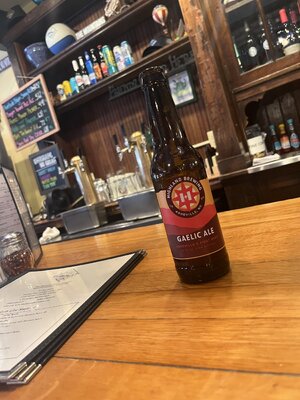Navigation
Install the app
How to install the app on iOS
Follow along with the video below to see how to install our site as a web app on your home screen.
Note: This feature may not be available in some browsers.
More options
You are using an out of date browser. It may not display this or other websites correctly.
You should upgrade or use an alternative browser.
You should upgrade or use an alternative browser.
This Date in History
- Thread starter nycfan
- Start date
- Replies: 707
- Views: 13K
- Off-Topic
Coincidence? I think not. My sister got on a plane to Vegas this morning. Meeting a cousin who happens to be a SDSU grad. Gloating shall occur.
1931 Nevada legalized gambling, which paved the way for casinos in the state, most notably in Las Vegas.
As an old school guy who enjoyed learning about real mobsters I always stayed at the Tropicana or Flamingo.
One time after a 10 day Canyon trip I arrived at a Forest Seviice campground on Mt. Charleston just west of Vegas. (Poor guy tgen. No afford hotel) and set up camp. One Wimnebago there. Great. Back to Vegas and walking aliong the strip,was just too much - people noise, lights. Turned around and back o the mountains, built a fire and looked down at the lights of Vegas. Impressive.
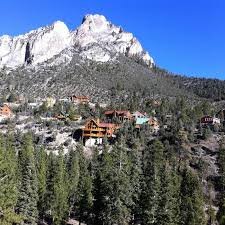
I’ve never been to Vegas. But I was flying to San Diego on business. The flight was at night and we were flying over the desert. If you looked out the window, the desert floor was pitch black. Here and there you could see little circles of light where a small town was. Eventually this huge dome of light appeared off to the north. The pilot told us it was Vegas. The view was like something out of a science fiction movie.
Last edited:
- Messages
- 1,102
Some hard core adventurers thos guys were.
1806 Lewis and Clark begin their trip home after an 8,000 mile trek of the Mississippi basin and the Pacific Coast.
The Lewis and Clark Expedition, also known as the Corps of Discovery Expedition, was the United States expedition to cross the newly acquired western portion of the country after the Louisiana Purchase. The Corps of Discovery was a select group of U.S. Army and civilian volunteers under the command of Captain Meriwether Lewis and his close friend Second Lieutenant William Clark. Clark, along with 30 others, set out from Camp Dubois (Camp Wood), Illinois, on May 14, 1804, met Lewis and ten other members of the group in St. Charles, Missouri, then went up the Missouri River. The expedition crossed the Continental Divide of the Americas near the Lemhi Pass, eventually coming to the Columbia River, and the Pacific Ocean in 1805. The return voyage began on March 23, 1806, at Fort Clatsop, Oregon, ending six months later on September 23 of that year.
President Thomas Jefferson commissioned the expedition, shortly after the Louisiana Purchase of 1803, to explore and detail as much of the new territory as possible. Furthermore, he wished to find a practical travel route across the western half of the continent—directly avoiding the hot and desolate desert southwest—and to establish an American presence in the new lands before European powers attempted to establish claims of their own. The campaign's secondary objectives were scientific, economical and humanitarian, i.e., to document the West's biodiversity, topography and geography and to establish positive trade relations with (potentially unknown) Native American tribes. The expedition returned to St. Louis to report their findings to President Jefferson via maps, sketches, and various journals.[1][2]
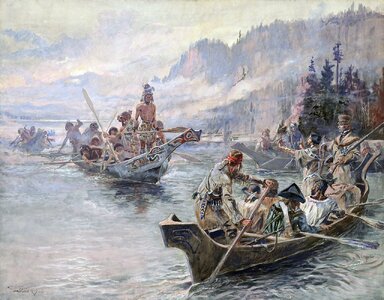
Corps of Discovery meet Chinooks on the Lower Columbia, October 1805 (Lewis and Clark on the Lower Columbia painted by Charles Marion Russel, c. 1905)
1806 Lewis and Clark begin their trip home after an 8,000 mile trek of the Mississippi basin and the Pacific Coast.
The Lewis and Clark Expedition, also known as the Corps of Discovery Expedition, was the United States expedition to cross the newly acquired western portion of the country after the Louisiana Purchase. The Corps of Discovery was a select group of U.S. Army and civilian volunteers under the command of Captain Meriwether Lewis and his close friend Second Lieutenant William Clark. Clark, along with 30 others, set out from Camp Dubois (Camp Wood), Illinois, on May 14, 1804, met Lewis and ten other members of the group in St. Charles, Missouri, then went up the Missouri River. The expedition crossed the Continental Divide of the Americas near the Lemhi Pass, eventually coming to the Columbia River, and the Pacific Ocean in 1805. The return voyage began on March 23, 1806, at Fort Clatsop, Oregon, ending six months later on September 23 of that year.
President Thomas Jefferson commissioned the expedition, shortly after the Louisiana Purchase of 1803, to explore and detail as much of the new territory as possible. Furthermore, he wished to find a practical travel route across the western half of the continent—directly avoiding the hot and desolate desert southwest—and to establish an American presence in the new lands before European powers attempted to establish claims of their own. The campaign's secondary objectives were scientific, economical and humanitarian, i.e., to document the West's biodiversity, topography and geography and to establish positive trade relations with (potentially unknown) Native American tribes. The expedition returned to St. Louis to report their findings to President Jefferson via maps, sketches, and various journals.[1][2]

Corps of Discovery meet Chinooks on the Lower Columbia, October 1805 (Lewis and Clark on the Lower Columbia painted by Charles Marion Russel, c. 1905)
donbosco
Inconceivable Member
- Messages
- 3,166
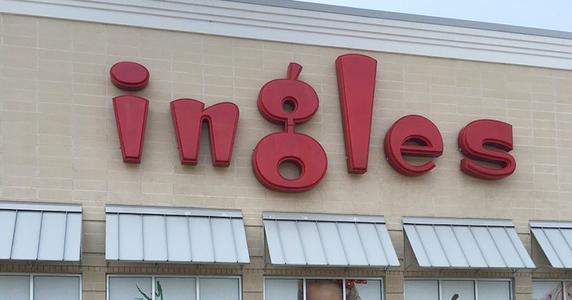
When we moved to Buncombe County 12-13 years ago my 5 year-old daughter was very pleased to see the name of our closest grocery store — INGLES. You see, she had been pretty immersed in Spanish since birth, thanks to Spanish for Fun Academy in Chapel Hill, then a kindergarten immersion program at Jones Elementary School in Greensboro, and seeing that name on the sign — which she read as Inglés and to her signified the Spanish word for English — was a comfortable message in a brand new place. I still often pronounce it as ENGLAYS to myself just for the fun of it.
#OTD in 1963 Robert Ingle opened his first supermarket on Hendersonville Road in Asheville. There are a lot of them now and they are all over the Southeast.
- Messages
- 1,173
Everything you need to know about what kind of person Clark was, is contained in the link posted below. Usually, I am overly cautious about holding people from the past to current ethical standards. But some behavior simply transcends any notions of time and place.Some hard core adventurers thos guys were.
1806 Lewis and Clark begin their trip home after an 8,000 mile trek of the Mississippi basin and the Pacific Coast.
The Lewis and Clark Expedition, also known as the Corps of Discovery Expedition, was the United States expedition to cross the newly acquired western portion of the country after the Louisiana Purchase. The Corps of Discovery was a select group of U.S. Army and civilian volunteers under the command of Captain Meriwether Lewis and his close friend Second Lieutenant William Clark. Clark, along with 30 others, set out from Camp Dubois (Camp Wood), Illinois, on May 14, 1804, met Lewis and ten other members of the group in St. Charles, Missouri, then went up the Missouri River. The expedition crossed the Continental Divide of the Americas near the Lemhi Pass, eventually coming to the Columbia River, and the Pacific Ocean in 1805. The return voyage began on March 23, 1806, at Fort Clatsop, Oregon, ending six months later on September 23 of that year.
President Thomas Jefferson commissioned the expedition, shortly after the Louisiana Purchase of 1803, to explore and detail as much of the new territory as possible. Furthermore, he wished to find a practical travel route across the western half of the continent—directly avoiding the hot and desolate desert southwest—and to establish an American presence in the new lands before European powers attempted to establish claims of their own. The campaign's secondary objectives were scientific, economical and humanitarian, i.e., to document the West's biodiversity, topography and geography and to establish positive trade relations with (potentially unknown) Native American tribes. The expedition returned to St. Louis to report their findings to President Jefferson via maps, sketches, and various journals.[1][2]
Corps of Discovery meet Chinooks on the Lower Columbia, October 1805 (Lewis and Clark on the Lower Columbia painted by Charles Marion Russel, c. 1905)
Link: York (explorer) - Wikipedia
Last edited:
- Messages
- 1,102
Used ro be an Ingle's on Merriman I'd stop at on way to,Mad Cty as the one on the Marshall by-pass was fairly grungy and no beer. Now there's the new suoer one at the 70 split at Weaverville.
When we moved to Buncombe County 12-13 years ago my 5 year-old daughter was very pleased to see the name of our closest grocery store — INGLES. You see, she had been pretty immersed in Spanish since birth, thanks to Spanish for Fun Academy in Chapel Hill, then a kindergarten immersion program at Jones Elementary School in Greensboro, and seeing that name on the sign — which she read as Inglés and to her signified the Spanish word for English — was a comfortable message in a brand new place. I still often pronounce it as ENGLAYS to myself just for the fun of it.
#OTD in 1963 Robert Ingle opened his first supermarket on Hendersonville Road in Asheville. There are a lot of them now and they are all over the Southeast.
- Messages
- 1,173
I used to always pull over at Ingles because it was one if the very few places where I could buy TruAde (at all) or Blenheim Ginger Ale (at a reasonable price.)
When we moved to Buncombe County 12-13 years ago my 5 year-old daughter was very pleased to see the name of our closest grocery store — INGLES. You see, she had been pretty immersed in Spanish since birth, thanks to Spanish for Fun Academy in Chapel Hill, then a kindergarten immersion program at Jones Elementary School in Greensboro, and seeing that name on the sign — which she read as Inglés and to her signified the Spanish word for English — was a comfortable message in a brand new place. I still often pronounce it as ENGLAYS to myself just for the fun of it.
#OTD in 1963 Robert Ingle opened his first supermarket on Hendersonville Road in Asheville. There are a lot of them now and they are all over the Southeast.
- Messages
- 1,102
- Messages
- 1,173
I agree. But also, attempting to go head-to-head with places like Food Lion, Publix, and Harris Teeter on location, price, and inventory would be a losing strategy for Ingles. The better strategy is to focus on essentials, niche/vintage/local products, and locations the "big boys" think are too rural. Ingles seems to be following a strategy of avoiding going head-to-head with larger chains. When Publix announced plans for Charlotte, Ingles sold all its locations to Harris Teeter. HT converted some of them to grocery stores and others were rented out to places like exercise and furniture franchises that need a large floor area.Yes. Ingles's grew up like most the big boys and started carrying better and high priced goods.
- Messages
- 1,102
I don't know about you but this is kind of a big deal for me. Would there be blue cups without it? [NOTE: In all my years at He's Not, I never had a blue cup. Long neck Bud's? Too many to comtemplate.]
On March 22, 1933, President Franklin D. Roosevelt signs the Beer and Wine Revenue Act. This law levies a federal tax on all alcoholic beverages to raise revenue for the federal government and gives individual states the option to further regulate the sale and distribution of beer and wine.
With the passage of the 18th Amendment and the Volstead Act in 1919, temperance advocates in the U.S. finally achieved their long sought-after goal of prohibiting the sale of alcohol or “spirits.” Together, the new laws prohibited the manufacture, sale or transportation of liquor and ushered in the era known as “Prohibition,” defining an alcoholic beverage as anything containing over 0.5 percent alcohol by volume. President Woodrow Wilson had unsuccessfully tried to veto the Volstead Act, which set harsh punishments for violating the 18th Amendment and endowed the Internal Revenue Service with unprecedented regulatory and enforcement powers. In the end, Prohibition proved difficult and expensive to enforce and actually increased illegal trafficking without cutting down on consumption. In one of his first addresses to Congress as president, FDR announced his intention to modify the Volstead Act with the Beer and Wine Revenue Act.
No fan of temperance himself, FDR had developed a taste for alcohol when he attended New York cocktail parties as a budding politician. (While president, FDR refused to fire his favorite personal valet for repeated drunkenness on the job.) FDR considered the new law “of the highest importance” for its potential to generate much-needed federal funds and included it in a sweeping set of New Deal policies designed to vault the U.S. economy out of the Great Depression.
The Beer and Wine Revenue act was followed, in December 1933, by the passage of the 21st Amendment, which officially ended Prohibition.
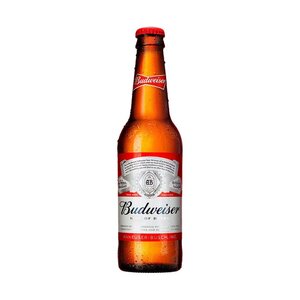

 en.m.wikipedia.org
en.m.wikipedia.org
On March 22, 1933, President Franklin D. Roosevelt signs the Beer and Wine Revenue Act. This law levies a federal tax on all alcoholic beverages to raise revenue for the federal government and gives individual states the option to further regulate the sale and distribution of beer and wine.
With the passage of the 18th Amendment and the Volstead Act in 1919, temperance advocates in the U.S. finally achieved their long sought-after goal of prohibiting the sale of alcohol or “spirits.” Together, the new laws prohibited the manufacture, sale or transportation of liquor and ushered in the era known as “Prohibition,” defining an alcoholic beverage as anything containing over 0.5 percent alcohol by volume. President Woodrow Wilson had unsuccessfully tried to veto the Volstead Act, which set harsh punishments for violating the 18th Amendment and endowed the Internal Revenue Service with unprecedented regulatory and enforcement powers. In the end, Prohibition proved difficult and expensive to enforce and actually increased illegal trafficking without cutting down on consumption. In one of his first addresses to Congress as president, FDR announced his intention to modify the Volstead Act with the Beer and Wine Revenue Act.
No fan of temperance himself, FDR had developed a taste for alcohol when he attended New York cocktail parties as a budding politician. (While president, FDR refused to fire his favorite personal valet for repeated drunkenness on the job.) FDR considered the new law “of the highest importance” for its potential to generate much-needed federal funds and included it in a sweeping set of New Deal policies designed to vault the U.S. economy out of the Great Depression.
The Beer and Wine Revenue act was followed, in December 1933, by the passage of the 21st Amendment, which officially ended Prohibition.


Beer bottle - Wikipedia
donbosco
Inconceivable Member
- Messages
- 3,166
This is an unforgettable sound-one of a different time & place-of the Textile Mill & the first blush of commodity capitalism, robber barons, & labor exploited & resisting. #OTD in 1892 (d. 1931) Banjo genius Charlie Poole was born in Randolph County (as a child his family moved to Spray, now Eden in Rockingham). His 3-finger style & carousing made him legend with his band the North Carolina Ramblers. Textile Workers were his people & he died young (before 40) living that hard life. He made some of the 1st Country Records. Ramble On, Charlie Poole Listen to his unique high-pitched voice & picking on “Don’t Let Your Deal Go Down.”
donbosco
Inconceivable Member
- Messages
- 3,166
I don't know about you but this is kind of a big deal for me. Would there be blue cups without it? [NOTE: In all my years at He's Not, I never had a blue cup. Long neck Bud's? Too many to comtemplate.]
On March 22, 1933, President Franklin D. Roosevelt signs the Beer and Wine Revenue Act. This law levies a federal tax on all alcoholic beverages to raise revenue for the federal government and gives individual states the option to further regulate the sale and distribution of beer and wine.
With the passage of the 18th Amendment and the Volstead Act in 1919, temperance advocates in the U.S. finally achieved their long sought-after goal of prohibiting the sale of alcohol or “spirits.” Together, the new laws prohibited the manufacture, sale or transportation of liquor and ushered in the era known as “Prohibition,” defining an alcoholic beverage as anything containing over 0.5 percent alcohol by volume. President Woodrow Wilson had unsuccessfully tried to veto the Volstead Act, which set harsh punishments for violating the 18th Amendment and endowed the Internal Revenue Service with unprecedented regulatory and enforcement powers. In the end, Prohibition proved difficult and expensive to enforce and actually increased illegal trafficking without cutting down on consumption. In one of his first addresses to Congress as president, FDR announced his intention to modify the Volstead Act with the Beer and Wine Revenue Act.
No fan of temperance himself, FDR had developed a taste for alcohol when he attended New York cocktail parties as a budding politician. (While president, FDR refused to fire his favorite personal valet for repeated drunkenness on the job.) FDR considered the new law “of the highest importance” for its potential to generate much-needed federal funds and included it in a sweeping set of New Deal policies designed to vault the U.S. economy out of the Great Depression.
The Beer and Wine Revenue act was followed, in December 1933, by the passage of the 21st Amendment, which officially ended Prohibition.

Beer bottle - Wikipedia
en.m.wikipedia.org
I remember quite vividly walking into He’s Not Here to see an absolute giant standing at the bar, his Afro scraping the popcorn ceiling and a Blue Cup in his hand looking more like a Dixie Cup.
Geoff Crompton could do that…
I went to high school with Geff (he was always changing the spelling). He was big in high school. He was 6-10 and weighed around 270. He got to Carolina and his weight ballooned to well over 300. He was 45-46 when he died. He never was really in to basketball. Said he played in large part because everyone expected him to because of his size.I remember quite vividly walking into He’s Not Here to see an absolute giant standing at the bar, his Afro scraping the popcorn ceiling and a Blue Cup in his hand looking more like a Dixie Cup.
Geoff Crompton could do that…
Last edited:
- Messages
- 1,102
The Gentle GiantI remember quite vividly walking into He’s Not Here to see an absolute giant standing at the bar, his Afro scraping the popcorn ceiling and a Blue Cup in his hand looking more like a Dixie Cup.
Geoff Crompton could do that…
True story. One summer I was regularly playing pick-up in Woolen. When campers came the Heels came over to play. Somehow I, as a regular, got chosen to play against them. Sweet D, Phil, etc. And Crompton. After going up for a rebound I was knocked to the floor with a busted lip from Geoff's elbow. And no he was not skying, lol. He freaked and was so concernd. Took a bit to stop the flow but no harm no foul.
From then on whenever I saw him at He's Not he'd smile, low 5 me and I'd buy him a beer. Yes, I'd buy as he never had much. Always a smile on his face.
Dean tried so hard to get him to work to his potential but it was just not in him. Dean loved the man still.
The coda. What I consider my greatest athletic accomplishment. Made a nice cross-over move and knocked down a 15 footer over Walter. He never let me get free from then on.
I remember a quiet afternoon in He’s Not…..we were outside at a table….I went up to get beers.I remember quite vividly walking into He’s Not Here to see an absolute giant standing at the bar, his Afro scraping the popcorn ceiling and a Blue Cup in his hand looking more like a Dixie Cup.
Geoff could do that…
The door was propped open….All of a sudden, the light coming inside disappeared…..I turned around to see why some asshole had closed the door…..no one had. It was just Geoff standing in the doorway. He filled it.
Wasn’t Geoff in Phil Ford’s class? I remember his freshman season…..Coach Smith saying not much aside from “Geoff has a lot of work to do to help us this year.”
Rumors were rampant that Geoff liked heading home for Momma’s home cooking. He was from Burlington, IIRC. Likely could have been in He’s Not.
As a SO, I remember Coach Smith saying, “If Geoff can get to 300 lbs., he can help us.”
I think that went up to 315 as a JR and SR. Great hands. Soft touch. Agile.
If he’d had Brad Daugherty’s work ethic, Geoff would be in the Hall of Fame.
Geff was a class ahead of Phil. He redshirted one year so they graduated from Carolina at the same time. As for his weight, he went over 315. I can remember in high school opposing centers being totally unable to stop him. He was 6-10 and 270. Most of the centers he faced were 6-2 to 6-5 and weighed a 100 pounds less than he did. They would foul him but most of the time it wasn’t called because it had no effect on him. Geff had a smooth shooting motion. He still holds the Burlington Williams record for field goals in a season and single season and career rebounding records. His jersey is the only basketball jersey retired at Williams. In our junior season we went to the 4-A state championship game. We lost by 2 points to a South Mecklenburg team led by Walter Davis. If Geff could have controlled his eating and drinking, he could have been a solid contributor off the bench.I remember a quiet afternoon in He’s Not…..we were outside at a table….I went up to get beers.
The door was propped open….All of a sudden, the light coming inside disappeared…..I turned around to see why some asshole had closed the door…..no one had. It was just Geoff standing in the doorway. He filled it.
Wasn’t Geoff in Phil Ford’s class? I remember his freshman season…..Coach Smith saying not much aside from “Geoff has a lot of work to do to help us this year.”
Rumors were rampant that Geoff liked heading home for Momma’s home cooking. He was from Burlington, IIRC. Likely could have been in He’s Not.
As a SO, I remember Coach Smith saying, “If Geoff can get to 300 lbs., he can help us.”
I think that went up to 315 as a JR and SR. Great hands. Soft touch. Agile.
If he’d had Brad Daugherty’s work ethic, Geoff would be in the Hall of Fame.
- Messages
- 1,102
How soon we forget.
The Exxon Valdez oil spill was a major environmental disaster that occurred in Alaska's Prince William Sound on March 24, 1989. The spill occurred when Exxon Valdez, an oil supertanker owned by Exxon Shipping Company, bound for Long Beach, California, struck Prince William Sound's Bligh Reef, 6 mi (9.7 km) west of Tatitlek, Alaska at 12:04 a.m. The tanker spilled more than 10 million US gallons (240,000 bbl) (or 37,000 tonnes)[1] of crude oil over the next few days.[2]
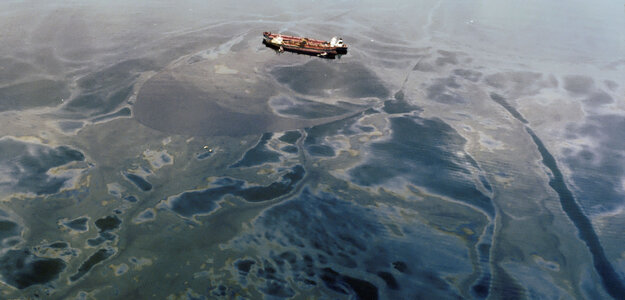
The Exxon Valdez spill is the second largest in U.S. waters, after the 2010 Deepwater Horizon oil spill, in terms of volume of oil released.[3][4] Prince William Sound's remote location, accessible only by helicopter, plane, or boat, made government and industry response efforts difficult and made existing response plans especially hard to implement. The region is a habitat for salmon, sea otters, seals, and seabirds. The oil, extracted from the Prudhoe Bay Oil Field, eventually affected 1,300 miles (2,100 km) of coastline, of which 200 miles (320 km) were heavily or moderately oiled.[2][5
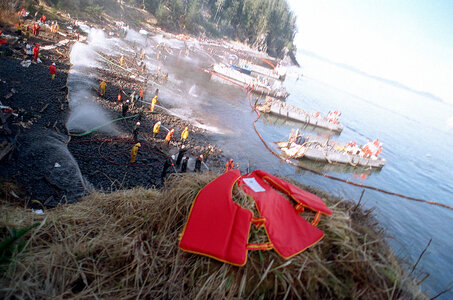
The Exxon Valdez oil spill was a major environmental disaster that occurred in Alaska's Prince William Sound on March 24, 1989. The spill occurred when Exxon Valdez, an oil supertanker owned by Exxon Shipping Company, bound for Long Beach, California, struck Prince William Sound's Bligh Reef, 6 mi (9.7 km) west of Tatitlek, Alaska at 12:04 a.m. The tanker spilled more than 10 million US gallons (240,000 bbl) (or 37,000 tonnes)[1] of crude oil over the next few days.[2]

The Exxon Valdez spill is the second largest in U.S. waters, after the 2010 Deepwater Horizon oil spill, in terms of volume of oil released.[3][4] Prince William Sound's remote location, accessible only by helicopter, plane, or boat, made government and industry response efforts difficult and made existing response plans especially hard to implement. The region is a habitat for salmon, sea otters, seals, and seabirds. The oil, extracted from the Prudhoe Bay Oil Field, eventually affected 1,300 miles (2,100 km) of coastline, of which 200 miles (320 km) were heavily or moderately oiled.[2][5

- Messages
- 1,173
I've read that less than 10% of the oil spilled was removed from Prince William Sound. And I bet Exxon was slapping itself on the back for almost hitting double figures in the recovery efforts. I did better at saving for retirement than Exxon did at cleaning up their mistake. I am not the standard that Exxon should have aspired to match.How soon we forget.
The Exxon Valdez oil spill was a major environmental disaster that occurred in Alaska's Prince William Sound on March 24, 1989. The spill occurred when Exxon Valdez, an oil supertanker owned by Exxon Shipping Company, bound for Long Beach, California, struck Prince William Sound's Bligh Reef, 6 mi (9.7 km) west of Tatitlek, Alaska at 12:04 a.m. The tanker spilled more than 10 million US gallons (240,000 bbl) (or 37,000 tonnes)[1] of crude oil over the next few days.[2]
The Exxon Valdez spill is the second largest in U.S. waters, after the 2010 Deepwater Horizon oil spill, in terms of volume of oil released.[3][4] Prince William Sound's remote location, accessible only by helicopter, plane, or boat, made government and industry response efforts difficult and made existing response plans especially hard to implement. The region is a habitat for salmon, sea otters, seals, and seabirds. The oil, extracted from the Prudhoe Bay Oil Field, eventually affected 1,300 miles (2,100 km) of coastline, of which 200 miles (320 km) were heavily or moderately oiled.[2][5

- Messages
- 1,102
Triangle shirtwaist factory fire, fatal conflagration that occurred on the evening of March 25, 1911, in a New York City sweatshop, touching off a national movement in the United States for safer working conditions.
The fire—likely sparked by a discarded cigarette—started on the eighth floor of the Asch Building, 23–29 Washington Place, just east of Washington Square Park. That floor and the two floors above were occupied by the Triangle Waist Company, a manufacturer of women’s shirtwaists (blouses) that employed approximately 500 people. The flames, fed by copious cotton and paper waste, quickly spread upward to the top two floors of the building. Fire truck ladders were only able to reach six stories, and the building’s overloaded fire escape collapsed. Many workers, trapped by doors that had been locked to prevent theft, leapt from windows to their deaths.
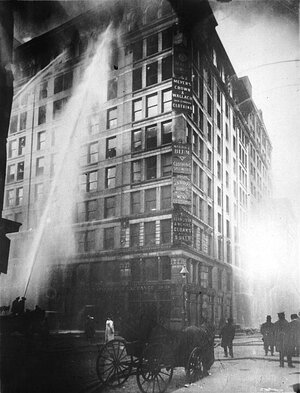
The 129 women and 17 men who perished in the 18-minute conflagration were mostly young European immigrants. It took several days for family members to identify the victims, many of whom were burned beyond recognition. Six of the victims, all interred under a monument in a New York City cemetery, were not identified until 2011 through research conducted by an amateur genealogist. A citywide outpouring of grief culminated on April 5, 1911, in a 100,000-strong procession behind the hearses that carried the dead along Fifth Avenue; thousands more observed the memorial gathering.
Though the owners of the factory were indicted later that month on charges of manslaughter, they were acquitted in December 1911; the owners ultimately profited from inflated insurance claims that they submitted after the tragedy. However, the uproar generated by the disaster led to the creation of the Factory Investigating Commission by the New York state legislature in June. Over the following year and a half, members of the commission visited factories, interviewed workers, and held public hearings. The commission’s findings ultimately led to the passage of more than 30 health and safety laws, including factory fire codes and child labour restrictions, and helped shape future labour laws across the country.
The fire—likely sparked by a discarded cigarette—started on the eighth floor of the Asch Building, 23–29 Washington Place, just east of Washington Square Park. That floor and the two floors above were occupied by the Triangle Waist Company, a manufacturer of women’s shirtwaists (blouses) that employed approximately 500 people. The flames, fed by copious cotton and paper waste, quickly spread upward to the top two floors of the building. Fire truck ladders were only able to reach six stories, and the building’s overloaded fire escape collapsed. Many workers, trapped by doors that had been locked to prevent theft, leapt from windows to their deaths.

The 129 women and 17 men who perished in the 18-minute conflagration were mostly young European immigrants. It took several days for family members to identify the victims, many of whom were burned beyond recognition. Six of the victims, all interred under a monument in a New York City cemetery, were not identified until 2011 through research conducted by an amateur genealogist. A citywide outpouring of grief culminated on April 5, 1911, in a 100,000-strong procession behind the hearses that carried the dead along Fifth Avenue; thousands more observed the memorial gathering.
Though the owners of the factory were indicted later that month on charges of manslaughter, they were acquitted in December 1911; the owners ultimately profited from inflated insurance claims that they submitted after the tragedy. However, the uproar generated by the disaster led to the creation of the Factory Investigating Commission by the New York state legislature in June. Over the following year and a half, members of the commission visited factories, interviewed workers, and held public hearings. The commission’s findings ultimately led to the passage of more than 30 health and safety laws, including factory fire codes and child labour restrictions, and helped shape future labour laws across the country.
Share:

